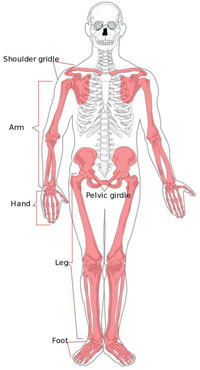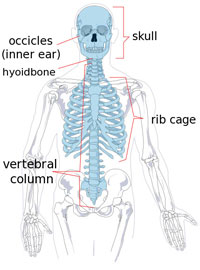The axial skeleton part of the human skeleton has 80 bones. It includes the vertebral column, the rib cage and the skull and helps us maintain our upright posture, by spreading the weight in the head, and upper areas down to the lower areas near the hips.
The human skeletal system has six major functions including the production of blood cells, for support, for movement, for protection, for storage of ions and endocrine regulation.
The longest bone in the human body is the thigh bone called the femur. The smallest bone found in the human body is located in the middle ear. The staples (or stirrup) bone is only 2.8 millimetres (0.11 inches) long. Like our skin, the human body's bones are also constantly worn down and re-made, to the point where every 7 years we essentially have a new bone. The area of our body with the most bones is the hand, fingers and wrist where there are 54 bones. Our teeth form part of the skeletal system, but are not counted as bones. There a just a few differences between human male and female skeletons. The female skeleton is generally slightly smaller and the pelvis bones differ in shape, size and angle in order to assist with child birth. The majority of human bones have a dense, strong outer layer, followed by a spongy part full of air for lightness, while the middle contains a soft, flexible, tissue substance called bone marrow. Bone marrow makes up 4% of a human body mass. It produces red blood cells which carry oxygen all over the body. Marrow is also produces lymphocytes, key components of the lymphatic system, which support the body's immune system. Calcium is very important for our bones and helps keep them strong and healthy. The areas where our bones meet are called joints. The joints in our cranium have no movement while our hip joints allow for a wide range of movement. Bones are held in place at joints by muscles and also tissues called ligaments. Another type of tissue called cartilage covers each bone joint surface area to prevent the bones rubbing. The medical branch of learning about the human skeletal system is called Orthopedics. There are a number of skeletal disorders, osteoporosis is a bone disease that increases the chance of fractures, scoliosis is a curvature of the spine, while arthritis is an inflammatory disease that damages joints.
| | |  
| | More Body Facts: | | | | | | | | | | | | | | Skeleton and Bones Facts | | | |
|